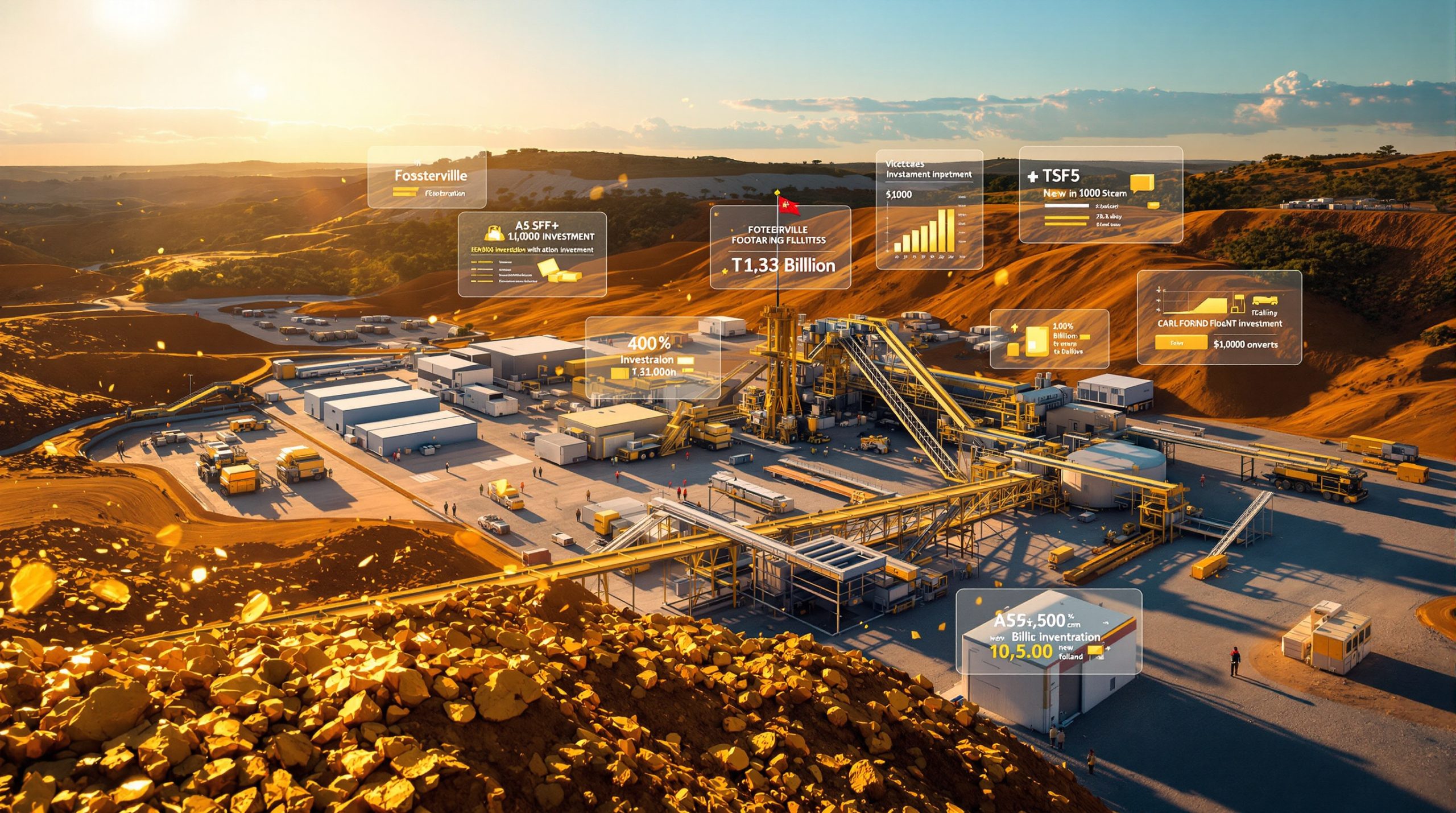Understanding Core Lithium's Northern Territory Advantage
The Core Lithium Finniss project represents a strategic departure from Australia's lithium mining concentration in Western Australia, offering unique positioning advantages that could reshape the nation's critical minerals supply chain. Located just 88 kilometers from Darwin Port, this operation provides unprecedented access to Asian battery markets while leveraging the Northern Territory's emerging mining infrastructure. Furthermore, this positioning aligns with broader australian lithium innovations emerging across the continent.
The project's geographic positioning creates substantial logistical benefits compared to traditional Western Australian operations. While major WA lithium mines typically face transport distances of 200-500 kilometers to reach Fremantle Port, the Finniss operation can deliver spodumene concentrate directly to Darwin's deep-water facilities within hours of processing completion.
Geographic and Logistical Benefits
Darwin Port's strategic location provides 15-20% shorter shipping times to key Asian manufacturing centers compared to routes from Fremantle. This proximity advantage translates to estimated cost savings of $15-25 per tonne for concentrate shipments, primarily through reduced overland transport requirements and elimination of secondary handling procedures.
The port infrastructure has been specifically enhanced for critical minerals exports, featuring:
- Deep-water berth access enabling year-round vessel loading
- Direct shipping lanes to Japan, South Korea, China, and Vietnam
- All-weather operational capability reducing seasonal transport disruptions
- Specialized handling equipment for spodumene concentrate storage and loading
This infrastructure investment positions Darwin as Australia's northern gateway for critical minerals trade, particularly benefiting early-stage producers seeking competitive transport solutions.
Project Scale and Resource Quality
The Core Lithium Finniss project encompasses a substantial resource base of 15.2 million tonnes at 1.26% lithium oxide, distributed across multiple deposits within the 500-square-kilometer Bynoe Pegmatite Field. This resource foundation supports projected mine life exceeding 20 years, substantially above the 10-15 year average for comparable Australian operations. Additionally, this extensive planning approach reflects modern mine planning principles being adopted across the industry.
The project's grade specifications place it competitively within industry standards, with processing designed to produce battery-grade spodumene concentrate containing 6%+ lithium oxide. This specification meets stringent requirements for lithium hydroxide production, the preferred feedstock for high-performance battery cathode materials.
How Does the Grants Deposit Transform Finniss Economics?
Recent optimisation of the Grants deposit mine plan represents a fundamental shift in project economics, delivering $35-45 million in pre-production capital savings while accelerating revenue generation timelines. The updated approach eliminates concurrent development of underground infrastructure, focusing initially on open pit extraction to depths of 145 meters below ground level.
Updated Mine Plan Financial Impact
The revised Grants strategy achieves revenue acceleration through an aggressive one-month timeline from mining mobilisation to first ore delivery. This timeline compression contrasts sharply with industry-standard commissioning periods of 3-6 months, providing substantial working capital advantages during the critical restart phase.
Key economic benefits include:
- Capital deferral: Underground development postponed until pit resources exhausted
- Revenue acceleration: Cash flow generation within 30 days of operations commencement
- Processing optimisation: Existing infrastructure fully utilised without idle asset carrying costs
- Risk mitigation: Reduced financing requirements during volatile lithium price environments
The financial modelling demonstrates that this approach improves project internal rate of return by approximately 2-3 percentage points while reducing peak funding requirements by $15-20 million compared to simultaneous open pit and underground development scenarios.
Ore Reserve Enhancement Details
Comprehensive geotechnical review enabled significant reserve expansion at the Grants deposit, with updated specifications showing 1.53 million tonnes at 1.42% lithium oxide. This represents a 44% increase in contained lithium content, achieved through advanced slope stability modelling and pegmatite structural characterisation.
The deeper pit design required innovative approaches to water management, wall stability, and access road engineering. Geotechnical analysis confirmed safe extraction parameters through:
- Advanced slope monitoring systems providing real-time stability assessment
- Dewatering infrastructure managing seasonal groundwater variations
- Bench design optimisation ensuring long-term structural integrity
- Equipment access protocols maintaining operational safety at increased depths
These technical achievements demonstrate the feasibility of extracting higher-grade ore from pegmatite formations while maintaining operational safety standards consistent with modern mine planning practices.
What Role Does the BP33 Deposit Play in Project Viability?
The BP33 deposit constitutes approximately 57% of total Finniss resources, containing 8.7 million tonnes at 1.38% lithium oxide. This substantial reserve provides operational flexibility through underground extraction methods, complementing the initial open pit focus at Grants while ensuring long-term production continuity.
High-Grade Resource Characteristics
BP33's 1.38% lithium oxide grade exceeds industry averages for spodumene pegmatite operations, typically ranging from 1.2-1.35%. This grade premium translates to processing advantages through:
- Reduced waste ratios in concentration circuits
- Lower per-unit processing costs due to higher head grades
- Superior concentrate yields approaching 85-90% recovery rates
- Product specification consistency maintaining battery-grade quality standards
The deposit's vertical to sub-vertical orientation favours underground extraction using conventional hard rock mining methods, including load-haul-dump vehicles and in-hole drilling equipment standard throughout Australian underground operations.
Production Optimisation Strategy
The dual-deposit approach enables strategic production sequencing based on market conditions, equipment availability, and operational requirements. During periods of strong lithium demand, both deposits can contribute ore to maximise processing plant utilisation, while market downturns allow selective mining from the most economically attractive source.
Underground mining at BP33 typically achieves:
- 85-92% ore recovery rates versus 75-85% for open pit operations
- Consistent production rates unaffected by weather conditions
- Lower surface disturbance supporting environmental compliance objectives
- Extended mine life through access to deeper, higher-grade pegmatite zones
This operational flexibility provides Core Lithium with portfolio optionality rarely available to single-deposit operations, particularly valuable during volatile commodity price cycles.
Why Did Core Lithium Suspend Operations and What's the Restart Plan?
Core Lithium suspended Finniss operations in January 2024 following significant lithium price declines that rendered continued production economically unviable. Lithium carbonate equivalent prices fell from peaks exceeding $60,000 per tonne in 2022 to ranges of $10,000-$20,000 per tonne throughout 2023-2024, compressing margins below sustainable levels for most producers.
Market-Driven Suspension Analysis
The suspension decision reflected comprehensive cash flow analysis determining that operational costs exceeded revenue projections at prevailing market prices. For spodumene concentrate producers, typical cost structures include:
- Mining costs: $8-12 per tonne ore processed
- Processing costs: $800-1,200 per tonne spodumene concentrate
- Transportation costs: $200-400 per tonne concentrate
- Total cash costs: $1,200-1,800 per tonne lithium oxide equivalent
At 2024 lithium prices below $15,000 per tonne, margin compression made continuation impossible without substantial capital injection or cost structure reorganisation.
Comprehensive Restart Strategy
The restart study, expected to complete by mid-2025, incorporates lessons learned from the suspension period while positioning the operation for sustainable profitability during lithium market recovery. Key strategic elements include:
Infrastructure Optimisation:
- Selective equipment upgrades targeting processing efficiency gains
- Maintenance protocol updates incorporating advanced predictive technologies
- Supply chain rationalisation reducing consumable and utility costs
- Labour structure optimisation reflecting post-suspension market realities
Capital Efficiency Measures:
- Pre-production cost reduction of $35-45 million through Grants optimisation
- Phased recommissioning spreading restart costs over 6-12 months
- Working capital minimisation through accelerated revenue generation
- Financing flexibility accommodating various market recovery scenarios
Industry precedent suggests successful lithium operation restarts typically correlate with sustained pricing above $18,000 per tonne lithium carbonate equivalent, providing adequate margins for capital recovery and operational sustainability.
How Does Finniss Compare to Other Australian Lithium Operations?
The Core Lithium Finniss project occupies a unique position within Australia's lithium landscape as the nation's only hard rock lithium operation outside Western Australia. This geographic distinction provides strategic advantages for both the company and broader supply chain security objectives. Consequently, this positioning supports the broader critical minerals strategy being developed nationally.
| Comparison Factor | Finniss Project | Typical WA Operations |
|---|---|---|
| Distance to Port | 88km to Darwin | 200-500km to Fremantle |
| Mine Life | 20+ years | 10-15 years average |
| Processing Location | On-site (NT) | Mixed on/off-site |
| Regional Diversity | Only NT operation | Concentrated in Pilbara |
| Asian Market Access | Direct shipping | Longer transport chains |
Strategic Market Positioning
Australia's lithium production remains heavily concentrated in Western Australia, with operations including Greenbushes (40,000+ tonnes Li2O capacity), Pilgangoora (50,000+ tonnes Li2O capacity), and Mount Marion (15,000+ tonnes Li2O capacity). This concentration creates supply chain risks during regional disruptions while limiting geographic diversification options for battery manufacturers.
Finniss provides unique value through:
- Supply chain diversification reducing single-region dependency risks
- Alternative logistics routing offering pricing competition for transport services
- Northern Territory development supporting regional economic objectives
- Critical minerals strategy alignment enhancing national resource security
The project's positioning supports Australian government initiatives promoting critical minerals production outside traditional mining regions, potentially qualifying for infrastructure support and development incentives.
Port infrastructure advantages at Darwin include:
- Natural deep-water harbour requiring minimal dredging or maintenance
- Shorter Asian shipping routes reducing transport time by 15-20%
- Dedicated critical minerals handling facilities designed for concentrate exports
- Year-round operational capability unaffected by seasonal restrictions
These infrastructure benefits create sustainable competitive advantages independent of commodity price cycles, positioning Finniss favourably for long-term market participation while contributing to Australian resource exports diversification.
What Are the Key Technical Innovations at Finniss?
The Core Lithium Finniss project incorporates several technical innovations addressing challenges specific to pegmatite lithium extraction in tropical environments. These solutions enhance operational efficiency while maintaining environmental compliance standards required in the Northern Territory.
Mining Method Optimisation
The transition from open pit to underground mining represents a carefully planned evolution maximising resource extraction while minimising infrastructure development costs. Advanced geotechnical modelling enabled pit depth extension to 145 metres below ground level, significantly beyond typical pegmatite extraction limits.
Key technical achievements include:
- Slope stability engineering utilising real-time monitoring systems
- Water management protocols addressing seasonal monsoon variations
- Equipment selection optimisation enabling dual-method operational flexibility
- Safety system integration maintaining standards across operational phases
The underground development plan incorporates decline access systems suitable for pegmatite geometry while accommodating standard hard rock mining equipment. This approach minimises specialised equipment requirements while maintaining extraction efficiency comparable to established operations.
Processing Technology Advantages
Spodumene concentrate production at Finniss utilises dense media separation and flotation technologies specifically optimised for pegmatite mineralogy. The processing circuit achieves 85-90% lithium recovery rates while producing concentrate specifications consistently meeting 6%+ lithium oxide requirements for battery-grade applications.
Environmental innovations include:
- Water recycling systems achieving 85%+ reuse rates
- Tailings management utilising dry stacking methods
- Dust suppression technologies incorporating advanced misting systems
- Noise mitigation measures protecting local wildlife habitats
These technical solutions address specific challenges associated with operating in proximity to Darwin while maintaining production efficiency standards competitive with established lithium operations.
How Does Finniss Support Australia's Critical Minerals Strategy?
The Core Lithium Finniss project aligns directly with Australian government objectives promoting domestic critical minerals production and supply chain diversification. As the nation's only lithium operation outside Western Australia, Finniss contributes to strategic resource security while supporting Northern Territory economic development. Moreover, this approach reflects the ongoing mining industry evolution towards more geographically distributed operations.
National Security Implications
Lithium's classification as a critical mineral reflects its essential role in battery technologies supporting defence applications, energy storage systems, and electric vehicle production. Domestic production capabilities reduce dependency on international sources while providing strategic stockpiling opportunities during supply disruptions.
Key strategic benefits include:
- Supply chain resilience through geographic diversification
- Processing capability retention maintaining domestic value-adding capacity
- Technology development support enabling advanced battery material research
- Export market positioning leveraging proximity to Asian manufacturing centres
The Northern Territory location provides additional security advantages through reduced transport exposure to potential supply chain disruptions affecting southern Australian ports or rail networks.
Export Market Dynamics
Asian battery manufacturers increasingly prioritise supply source diversification to mitigate concentration risks in critical material procurement. Finniss offers an alternative to Western Australian suppliers while maintaining Australian quality standards and regulatory compliance.
Market positioning advantages include:
- Price discovery alternatives providing negotiating leverage for buyers
- Delivery flexibility through direct Darwin Port access
- Quality assurance maintaining consistent battery-grade specifications
- Long-term supply security supported by 20+ year reserve base
These factors position Finniss to secure premium pricing for spodumene concentrate while contributing to Australia's broader critical minerals export objectives.
What Are the Investment Implications of Finniss Development?
Investment analysis of the Core Lithium Finniss project reveals compelling economics supported by strategic location advantages, optimised development planning, and substantial resource base. The updated mine plan delivers six-fold returns on pre-production capital while generating projected free cash flow of $1.2 billion over the mine life.
Financial Performance Projections
The restart strategy incorporates conservative lithium price assumptions while maximising operational efficiency through infrastructure optimisation and capital deferral strategies. Key financial metrics include:
- Pre-production capital reduction of $35-45 million through Grants optimisation
- Working capital minimisation via one-month revenue acceleration
- Operating cost competitiveness targeting lower quartile industry performance
- Cash flow sustainability across commodity price cycles
Market timing considerations suggest optimal restart conditions emerge when sustained lithium prices exceed $18,000 per tonne lithium carbonate equivalent, providing adequate margins for capital recovery and shareholder returns.
Risk Assessment and Mitigation
Investment risks reflect both commodity price volatility and operational execution challenges common to mining restart scenarios. However, Finniss demonstrates superior risk mitigation through proven infrastructure, regulatory stability, and strategic market positioning.
Primary risk factors include:
- Lithium price volatility managed through flexible production scheduling
- Operational restart complexity mitigated by existing infrastructure and experienced management
- Regulatory compliance supported by Northern Territory's stable mining framework
- Environmental obligations addressed through established monitoring and management systems
Risk mitigation strategies encompass:
- Market diversification through multiple potential offtake partners
- Production flexibility enabling rapid response to price signals
- Cost structure optimisation maintaining competitiveness during downturns
- Financial discipline preserving capital for optimal market reentry timing
These factors position Finniss as a lower-risk lithium investment compared to development-stage projects while offering substantial upside during lithium market recovery.
FAQ: Core Lithium Finniss Project Key Questions
Q: When will Core Lithium restart operations at Finniss?
A: The restart study is expected to complete by mid-2025, with the final decision dependent on market conditions and board approval. Current lithium prices remain below sustainable operational levels, though industry analysts anticipate potential recovery during 2025-2026 driven by electric vehicle demand growth.
Q: What makes Finniss different from Western Australian lithium mines?
A: Finniss is Australia's only lithium operation outside WA, offering superior port access (88km vs 200-500km), direct Asian market shipping routes, and regional supply diversification. The Northern Territory location provides strategic alternatives for battery manufacturers seeking geographic risk mitigation.
Q: How much lithium can Finniss produce annually?
A: While specific production targets depend on the restart configuration, the project's 15.2 million tonne reserve supports 20+ years of continuous operation. Processing capacity typically ranges from 500-1,500 tonnes per day for pegmatite operations of this scale.
Q: What is the significance of the Grants deposit upgrade?
A: The updated Grants mine plan reduces pre-production costs by $35-45 million while accelerating first ore delivery to within one month of mobilisation. This optimisation fundamentally improves project economics through capital deferral and revenue acceleration.
Q: How does the BP33 deposit contribute to overall project value?
A: BP33 contains approximately 57% of total Finniss resources (8.7 million tonnes at 1.38% Li2O), providing operational flexibility through underground mining methods and ensuring production continuity beyond the initial Grants open pit phase.
Q: What are the main investment risks for Finniss?
A: Primary risks include lithium price volatility, operational restart complexity, and market timing uncertainty. However, these are mitigated by proven infrastructure, strategic location advantages, regulatory stability, and flexible production capabilities.
Future Outlook for Finniss Project Development
Market Recovery Positioning
Lithium demand projections support optimistic medium-term outlook driven by electric vehicle adoption acceleration and energy storage system deployment across developed markets. Industry analysts forecast demand growth of 15-20% annually through 2030, potentially creating supply deficits supporting price recovery to sustainable levels.
Demand drivers include:
- Electric vehicle market expansion targeting 30%+ global market share by 2030
- Grid-scale energy storage supporting renewable energy integration
- Consumer electronics growth maintaining baseline lithium consumption
- Industrial application development expanding lithium use cases
These trends support lithium price recovery scenarios enabling profitable Finniss operations while justifying restart capital deployment.
Expansion Potential Assessment
The 500-square-kilometre Bynoe Pegmatite Field contains numerous unexplored targets beyond the established Grants and BP33 deposits. Exploration programmes continue evaluating Blackbeard, Carlton, and additional pegmatite occurrences throughout the project area.
Expansion opportunities include:
- Resource base growth through systematic pegmatite exploration
- Processing capacity scaling accommodating additional ore sources
- Regional hub development supporting Northern Territory lithium industry
- Value-adding initiatives potentially including lithium hydroxide production
These prospects position Finniss for substantial growth beyond current reserve estimates while supporting Australia's critical minerals strategy objectives and Northern Territory economic development initiatives.
Disclaimer: This analysis is based on publicly available information and should not be considered investment advice. Lithium markets remain volatile, and mining investments carry inherent risks including commodity price fluctuations, operational challenges, and regulatory changes. Potential investors should conduct thorough due diligence and consult qualified financial advisors before making investment decisions.
Could Finniss Signal the Next Major Lithium Discovery?
Core Lithium's strategic positioning in the Northern Territory demonstrates how geographic diversification can create substantial competitive advantages in the critical minerals sector. With lithium demand projected to grow 15-20% annually through 2030 and the potential for significant price recovery, Discovery Alert's proprietary Discovery IQ model helps investors identify similar opportunities across ASX-listed exploration and mining companies before they become mainstream market movements. Begin your 30-day free trial today to position yourself ahead of the market and discover why historic mineral discoveries have generated exceptional returns for early investors.




